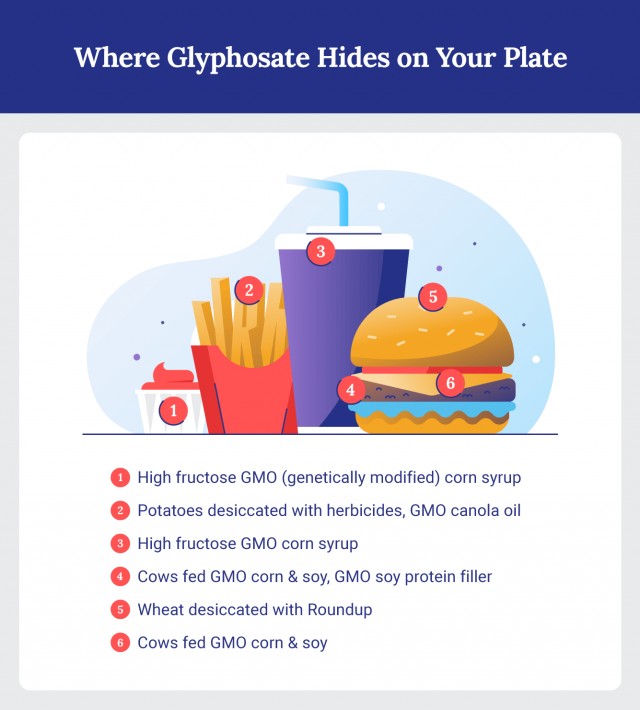Glyphosate, the active ingredient in many herbicides, including the widely known Roundup, has become a subject of increasing concern for consumers. Introduced in 1974, Roundup’s initial testing suggested low risks to humans, leading to widespread acceptance and high exposure limits. However, with the volume of glyphosate applied to crops increasing exponentially since the late 1970s and the introduction of glyphosate-resistant crops in 1996, understanding what glyphosate is and how to avoid it in food is crucial. This guide provides a comprehensive overview of glyphosate, its potential risks, and practical steps you can take to minimize your exposure.
Understanding Glyphosate: The Basics
Glyphosate is a broad-spectrum herbicide used globally to control weeds. Farmers rely on its effectiveness in protecting crops from invasive plant life that can significantly reduce yields. Glyphosate-resistant crops are genetically engineered to withstand the herbicide, allowing farmers to target weeds without harming the crops themselves. This widespread use has led to concerns about glyphosate residues in food products.
Is Glyphosate Harmful? Navigating the Conflicting Research
The safety of glyphosate is a topic of ongoing debate within the scientific community. While regulatory agencies like the Environmental Protection Agency (EPA) maintain that glyphosate is “not likely to be carcinogenic to humans,” the World Health Organization (WHO) has classified it as “probably carcinogenic” in 2016. This conflicting information makes it challenging for the public to assess the actual risks.
Bayer, the company that owns the Roundup brand, announced in 2021 that it would cease selling Roundup in the residential lawn and garden market by 2023, citing risks to farmworkers and consumers. This decision followed a court order requiring Bayer to pay over $80 million in damages to a man who claimed Roundup caused his non-Hodgkin lymphoma. These events highlight the potential health risks associated with glyphosate exposure.
Practical Tips to Reduce Glyphosate Exposure in Your Diet
Taking proactive steps to limit glyphosate intake is essential for making informed dietary choices. Here are four actionable strategies:
1. Look for the “Glyphosate Residue Free” Label
The Detox Project offers a certification process that verifies products are free from glyphosate contamination. This certification involves testing by an accredited third-party laboratory to ensure products meet strict standards. Look for this label when shopping to identify products that have been tested and confirmed to be glyphosate-free.
2. Consult Lists of Glyphosate-Free Products
The Detox Project maintains a list of certified Glyphosate Residue Free products, providing consumers with a valuable resource for finding alternatives to potentially contaminated items. Regularly reviewing this list can help you make informed purchasing decisions.
3. Prioritize Organic Foods Whenever Feasible
Choosing organic produce is a proactive way to avoid glyphosate exposure because certified organic produce is grown without synthetic herbicides or pesticides. While eating organic may not completely eliminate exposure, it can significantly reduce it. A recent study indicated that individuals who consumed an all-organic diet for just six days experienced a 70% reduction in glyphosate levels in their bodies.
4. Avoid Using Glyphosate-Based Weed Killers in Your Garden
When growing your own produce, avoid using Roundup or other glyphosate-based weed killers. Numerous Roundup alternatives are available, including organic products and DIY recipes.
Glyphosate in Food: Which Foods to Watch Out For
Research has shown that certain foods are more likely to contain glyphosate residues. For example, a study by the Environmental Working Group (EWG) found glyphosate in over 95% of oat-based food samples. Cereals marketed to children were identified as particularly high in glyphosate.
Foods with high levels of glyphosate:
- Honey Nut Cheerios Medley Crunch (833 ppb)
- Nature Valley Crunchy Granola Bars, Maple Brown Sugar (566 ppb)
- Nature Valley Granola Cups, Almond Butter (529 ppb)
- Chocolate Peanut Butter Cheerios (400 ppb)
- Nature Valley Baked Oat Bites (389 ppb)
- Nature Valley Crunchy Granola Bars, Oats and Honey (320 ppb)
- Nature Valley Crunchy Granola Bars, Peanut Butter (312 ppb)
- Nature Valley Granola Cups, Peanut Butter Chocolate (297 ppb)
- Nature Valley Fruit & Nut Chewy Trail Mix Granola Bars, Dark Chocolate Cherry (275 ppb)
- Nature Valley Protein Granola, Oats and Dark Chocolate (261 ppb)
- Multi Grain Cheerios (216 ppb)
- Nature Valley Soft-Baked Oatmeal Squares, Blueberry (206 ppb)
- Fiber One Soft-Baked Cookies, Oatmeal Raisin (204 ppb)
- Nature Valley Granola, Peanut Butter Creamy & Crunchy (198 ppb)
- Nature Valley Biscuits with Almond Butter (194 ppb)
Choosing Safer, Glyphosate-Free Foods
The Environmental Working Group (EWG) publishes an annual “Clean Fifteen” list, which identifies the fruits and vegetables with the lowest pesticide residues, based on USDA data. Approximately 70% of the samples on this list had no detectable pesticide residues, making them safer choices for consumers.
The 2022 Clean Fifteen:
- Avocados
- Sweet corn
- Pineapple
- Onions
- Papaya
- Sweet peas (frozen)
- Asparagus
- Honeydew melon
- Kiwi
- Cabbage
- Mushrooms
- Cantaloupe
- Mangoes
- Watermelon
- Sweet potatoes
By prioritizing these foods and following the other tips outlined above, you can significantly minimize your exposure to glyphosate and other pesticides.
Conclusion: Informed Choices for a Healthier Diet
Reducing exposure to glyphosate requires awareness and proactive planning. While the scientific community continues to investigate the long-term health effects of glyphosate, taking steps to minimize your intake can empower you to make informed dietary choices. By looking for glyphosate-free labels, choosing organic produce when possible, and staying informed about the foods most likely to contain glyphosate residues, you can take control of your health and protect yourself and your family from potential risks.
